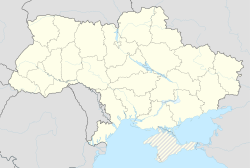Dolyna
| Dolyna Долина | |||
|---|---|---|---|
 Central part of Dolyna | |||
| |||
 Dolyna Долина | |||
| Coordinates: 48°58′14″N 24°0′40″E / 48.97056°N 24.01111°E / 48.97056; 24.01111 | |||
| Country | |||
Oblast (province) | Ivano-Frankivsk | ||
Raion (district) | Dolyna Raion | ||
| Government | |||
| • Mayor | Volodymyr Harazd | ||
| Population (2016) | |||
| • Total | 20,775 | ||
Dolyna (Ukrainian: Доли́на, Polish: Dolina, Yiddish: דאלינע) is a city located in Ivano-Frankivsk Oblast (region) in southwestern Ukraine. It is the administrative center of Dolyna Raion (district). Population: 20,775 (2016 est.)[1]. In 2001, population was around 20,900.
Contents
1 History
2 People
3 Football
4 Gallery
5 Sister cities
6 Location
7 References
8 External links
History
The city's history reaches the 10th century, making it one of oldest in the region. By the 14th century Dolyna became renowned for its salt mine. In 1349 the city came under the rule of the Kingdom of Poland, where it remained until 1772 (see Partitions of Poland). In 1525 Dolyna, or Dolina, as it is called in Polish, was granted city rights under the Magdeburg law and the right to trade salt similar to that of Kolomyia. In 1740 in the city there was a riot of opryshky (Ukrainian rebels).
In 1772 the city fell to Austrians and in 1791 it lost its status. During the second half of the 19th century a railroad line linking Stryi with Stanislaviv was led through the city. By the end of the 19th century big fires destroyed the town completely. The first decade of the new century was dedicated to the revival of the town. After the collapse of Austria-Hungary, reborn Polish and Ukrainian states struggled for control over Dolyna in a fratricidal war won by Poles (see Polish-Ukrainian War). In the Second Polish Republic, the town, with population of almost 10 000, belonged to the Stanisławów Voivodeship and was the capital of the Dolina County. Neighboring villages were inhabited by German settlers, who came there in the times of Joseph II.
During World War II the city was occupied by the USSR (September 1939 - June 1941) and Germans, and incorporated into the Ukrainian SSR.
In the 1950s, oil deposits were discovered in the region which by 1958 produced 65% of oil extracted in the Ukrainian SSR. In the 1960s the Dolynske oil field was the oil field that produced the largest amount of oil of the whole USSR.[2]
Since 1991, Dolyna is in independent Ukraine. Its oil field is one of the most powerful of Ivano-Frankivsk Oblast (region).[2]
People
Most prominent among the people hailing from the city was Myroslav Ivan Lubachivsky, Major Archbishop of Lviv and head of the Ukrainian Church. Among other notable inhabitants of Dolyna, there is Rudolf Regner, a hero of the Polish World War II resistance.
Other famous personalities associated with Dolyna are:
Stanislaw Jaworski - Polish film and theatre actor,
Antoni Kepinski - Polish psychiatrist and philosopher,
Ivan Levynskyi - Ukrainian architect,
Wladyslaw Ogrodzinski - Polish writer and journalist
Football
The city has a football club FC Naftovyk Dolyna.
Gallery

Dolyna hospital

Early 20th century church
Historical building in Dolyna

District court

Greek Catholic church

Roman Catholic church

Gymnasium

"Sokil" fellowship building

Former synagogue
Sister cities
 Prairie Village, United States
Prairie Village, United States
Location
- Local orientation
- Regional orientation
References
^ "Чисельність наявного населення України (Actual population of Ukraine)" (PDF) (in Ukrainian). State Statistics Service of Ukraine. Retrieved 19 July 2016..mw-parser-output cite.citation{font-style:inherit}.mw-parser-output q{quotes:"""""""'""'"}.mw-parser-output code.cs1-code{color:inherit;background:inherit;border:inherit;padding:inherit}.mw-parser-output .cs1-lock-free a{background:url("//upload.wikimedia.org/wikipedia/commons/thumb/6/65/Lock-green.svg/9px-Lock-green.svg.png")no-repeat;background-position:right .1em center}.mw-parser-output .cs1-lock-limited a,.mw-parser-output .cs1-lock-registration a{background:url("//upload.wikimedia.org/wikipedia/commons/thumb/d/d6/Lock-gray-alt-2.svg/9px-Lock-gray-alt-2.svg.png")no-repeat;background-position:right .1em center}.mw-parser-output .cs1-lock-subscription a{background:url("//upload.wikimedia.org/wikipedia/commons/thumb/a/aa/Lock-red-alt-2.svg/9px-Lock-red-alt-2.svg.png")no-repeat;background-position:right .1em center}.mw-parser-output .cs1-subscription,.mw-parser-output .cs1-registration{color:#555}.mw-parser-output .cs1-subscription span,.mw-parser-output .cs1-registration span{border-bottom:1px dotted;cursor:help}.mw-parser-output .cs1-hidden-error{display:none;font-size:100%}.mw-parser-output .cs1-visible-error{font-size:100%}.mw-parser-output .cs1-subscription,.mw-parser-output .cs1-registration,.mw-parser-output .cs1-format{font-size:95%}.mw-parser-output .cs1-kern-left,.mw-parser-output .cs1-kern-wl-left{padding-left:0.2em}.mw-parser-output .cs1-kern-right,.mw-parser-output .cs1-kern-wl-right{padding-right:0.2em}
^ ab (in Ukrainian) Dirty lands. As Kolomoisky struggles with the community for the sake of oil profits, Economichna Pravda (10 April 2018)
External links
(in English) Dolyna at the Encyclopedia of Ukraine
(in Ukrainian) Unofficial city site
(in Ukrainian) City history, description, and photos
(in English) English-speaking forum of Dolyna
(in English) Photographs of Jewish sites in Dolyna
Coordinates: 48°58′14″N 24°0′40″E / 48.97056°N 24.01111°E / 48.97056; 24.01111










